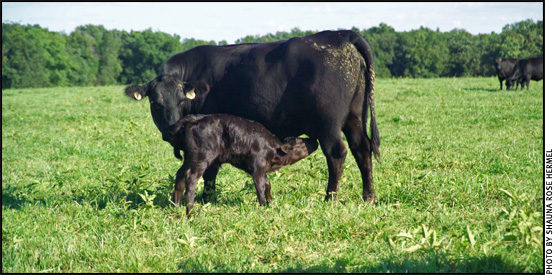 Assisting at Birth
Assisting at Birth
K-State's Matt Miesner offers tips for determining when assistance is needed.
If a cow or heifer is taking too long in labor, and the feet of the calf are not yet showing, it's always wise to check the position and size of the calf to see if assistance is needed.
Matt Miesner, assistant professor of clinical ag practices at Kansas State University's (K-State's) Veterinary Teaching Hospital, says you need to determine which legs of the calf you are feeling — whether front or back. You can usually tell by feeling the joints to know whether you are feeling the knees or hocks. The first two joints in the front leg flex the same direction. In the hind leg, the hock bends the opposite direction of the fetlock joint.
"In some instances you may find the joints are not bending, and you might realize it's a calf with arthrogryposis (fused joints) from a genetic defect or toxic plants (such as lupine or hemlock) the cow ate during early pregnancy," says Miesner. Some of these calves are difficult to deliver through the birth canal and must be removed by fetotomy (cutting the calf apart) or C-section.
Knowing what you are feeling when you check inside the cow can help you determine whether you can pull the calf or need your veterinarian. If the cow is having twins, it's sometimes difficult to determine which leg belongs to which calf.
"If it's twins, often one will come backward and the other frontward, and you have a front leg and a back leg. You need to make sure that if you are pulling two legs, they connect to the same body," he says.
Feeling the size of the feet can give a clue regarding overall size of a calf and whether it can be pulled or must be delivered by C-section.
"Determining this usually comes from experience. If you reach in and find it's a huge foot, you may know that this calf can't be easily pulled," Miesner says. Another clue is whether you can force your fingers between the calf's head and the cow's pelvis. If the calf's forehead is hitting the pelvis it cannot come through.
 It also helps if you can determine whether you are feeling the shoulder or the neck and no legs, to know how the calf is lying in the uterus and what you might have to do to straighten it. If you reach in and can't get to the calf because there are membranes in the way, the problem might be torsion of the uterus. If the uterus has rotated, there will be a twist at the cervix and the calf can't come through.
It also helps if you can determine whether you are feeling the shoulder or the neck and no legs, to know how the calf is lying in the uterus and what you might have to do to straighten it. If you reach in and can't get to the calf because there are membranes in the way, the problem might be torsion of the uterus. If the uterus has rotated, there will be a twist at the cervix and the calf can't come through.
"If you've never encountered this problem before, you might think the cow is just not dilated yet," says Miesner. In a complete torsion you may need veterinary assistance to turn the uterus back to proper position, or deliver the calf by C-section if these efforts fail.
[Click here to go to the top of the page.]





